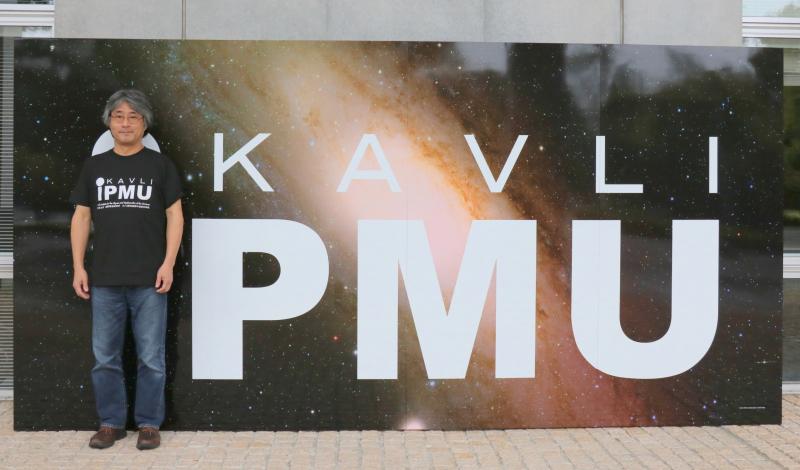(Originally appeared in the 2016 Kavli IPMU Annual Report)
※This article has been partially revised.

Hitoshi Murayama
I’m amazed. This annual report covers our activity through the Japanese Fiscal Year 2016, and the WPI funding was supposed to have finished on March 31, 2017. Then why haven’t we disappeared from the map by now? The Institute for the Physics and Mathematics of the Universe was launched on October 1, 2007. The WPI funding was promised for nine-and-a-half years. We started to recruit the very best scientists with the fear that they may all leave well before the end of this period. It is a culmination of many forces and sheer luck that got us through these years and beyond.
Kenzo Nakamura was just about to retire from KEK, and agreed to come as the Administrative Director on October 16. He was IPMU Employee #1. Since then, he started to assemble a team of competent staff to get ready for the anticipated arrival of many scientists, with a large fraction from other countries. All the PIs worked hard to advertise the new institute and announced a large number of available positions. At the same time, many of our research projects, most notably the Hyper Suprime-Cam on the Subaru telescope, had started but were constrained by funding. I began my appointment only on January 1, 2008 because of my duties in Berkeley which I had to complete. Kenzo worked out my appointment, which was approved only a few days before my arrival.
Many young faculty started to arrive soon, mostly Japanese at the beginning. Kenzo and I worked with our staff to change their mindset from the traditional system to a new open and forward-looking system. Surprisingly, they were very eager to tackle new challenges. Soon enough, the web site our staff put together received the President’s award, the first recognition by the University that IPMU was off to something good. Yet when the first batch of young international postdocs started to arrive in fall 2008, it was quite a bit of chaos and trial and error. Thanks to the dedication of our staff, we managed to create a system that supports international scientists very well so that they could kick start their research soon after they arrived. The vast majority of initial postdocs are already on faculty positions elsewhere in the world because of their great research accomplishments at IPMU. Given their success, IPMU started to become known to the world, and more people came for workshops and appointments. We started to attract international faculty members. Our building momentum caught the attention of the University administration, and they created Todai Institutes for Advanced Study (TODIAS) to house IPMU, later renamed as UTokyo Institutes for Advanced Study (UTIAS). It was originally meant to be a purely organizational issue, but it turned out to have critical importance later.
Thanks to the wise decision by Executive Vice President Nishio, we could build our wonderful building by borrowing money from ten-years of overhead up front. Thanks to the strong support by Executive Vice President Okamura, we could launch daily tea times, and create a flexible appointment system. Thanks to then-Presidents Komiyama and Hamada, we started to obtain permanent positions, despite the fixed-term nature of funding. The Kavli Foundation observed this development, and decided to make IPMU the first Kavli Institute in Japan; actually the first institute in Japan named after any donor, not to even speak of an international donor. It broke new ground, and gave us greater visibility. IPMU became Kavli IPMU in 2012. The Foundation had intended to make this happen earlier, but was delayed by Lehman shock in 2008.
Yet the Lehman shock helped. It prompted the Japanese government to create an economic stimulus package, which included large funding called FIRST to 30 individuals. By sheer luck, I managed to get one approved, without which the current major project Hyper Suprime-Cam would not have been completed, nor the next major project Prime Focus Spectrograph launched.
We were very keen on public outreach from the onset, because of our sense of our obligation to bring back the research products to those who paid for them, namely the general public. Unexpectedly, it created a strong public support for Kavli IPMU, by being volunteers, providing donations, and just being fans.
All of them combined, we received the top mark from the interim review on Dec 2012. Mr. Towatari, then a high-ranking official at MEXT, suggested that we should go after permanent funding that goes beyond WPI. The TODIAS framework gave us the right to put forward a budget request. It took several years to materialize, but without his suggestion, we would not have put in such a request. It started to produce permanent funding so that Kavli IPMU could go on beyond the WPI funding.
In the mean time, our scientists kept producing world class research as we have shown in the annual reports the last nine times. Then in October 2015, we were overjoyed when one of our PIs, Takaaki Kajita was announced as a recipient of the Nobel Prize in Physics!
If we had missed any one of them above, we would not be here today.






